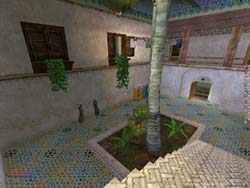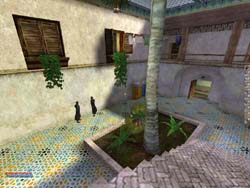 |
|
|
|
In the Forums... |
Posted: December 12, 2000 Written by: Tuan "Solace" Nguyen Advanced Display Options (cont.) The next option is called Lightmaps. Use of this option makes atmospheric lighting look very realistic. If you turn it off, the game will use vertex lighting and everything will basically look the same. Turn Lightmaps off if you find that the graphics are slow when you play. If things are fine when you start playing without modifying this option, then just leave it as is.   Lightmaps Off Lightmaps On Mirrors are Shadows are self-explanatory. Mirrors include reflections in things such as glass and water while shadows adds to the lighting effect and make things look more realistic. These two options also will result in a performance hit if enabled. No One Lives Forever is a highly detailed game, so you may want these options off if your system isn't up to the task. Lower down in the options menu is a setting called Environment Maps. This setting lets the game wrap the surrounding scenery to objects that are reflective, and it also creates a better sense of depth and realism. Turning this option on will give a performance hit when youíre in-game. I advise keeping this setting turned off if you want to gain speed on a slower system. The Model chrome option makes metallic objects shine and reflect the surrounding environment. This option takes a little hit on performance because of the environment reflections. Trilinear filtering will filter pixels cubically. This will remove the banding effect seen on textures when games use standard Bilinear filtering. This reduces frame rates slightly, and makes the game look smoother when youíre moving around. Lastly, we have triple buffering, which I already explained above. In-Game Special Effects  Check that girl out! When youíre inside the game there is an option called Sound filtering effects inside the Options menu. Turning this option on gives you really nice atmospheric sounds through the game but itíll really kill performance. These effects include sound muffling thatís caused when youíre firing something under water, or wall acoustics. Only people with high end systems should enable this option. |
||
|
| |||
|---|---|---|---|